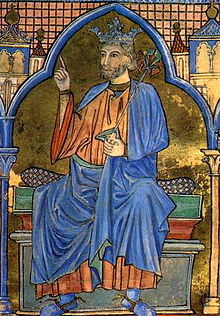Ferdinand III. (Castile)

Ferdinand el Santo , called "the saint" (* July 30 or August 5, 1199 in the monastery Valparaíso near Zamora ; † May 30, 1252 in Seville ), was from 1217 as Ferdinand II. King of Castile and from 1230 as Ferdinand III. King of Castile and León . He is considered one of the most important rulers in Spain.

Life
Ferdinand was born in 1199 as the son of King Alfonso IX. Born of León and Berenguela of Castile , daughter of Alfonso the Noble of Castile. Pope Innocent III However, the parents' marriage was annulled in 1203 because they were too closely related, because Berenguela's great-grandfather Alfonso VII was also her husband's grandfather. After the death of his uncle Henry I , Ferdinand became king of Castile in 1217 and, after the death of his father (1230), of León , which he united with Castile as well as Asturias and Galicia to form an indivisible kingdom that was inherited by the eldest son. This laid the foundation for the greatness of Castile and ultimately for the liberation from Moorish rule in Spain.
Ferdinand gradually won after several victories over the Moors, especially at Jerez de la Guadiana (1233), the capture of Cordoba (1236), the conquest of Jaén (1246), Seville (1248), Cadiz (1250) and other cities Control of large parts of the north and south of the Iberian Peninsula . The Castilian rule then extended to the Mediterranean.
Only the kingdom of Granada remained under the Moors, but under Castilian suzerainty. The result was a massive emigration of the Moors from the lands recaptured by the Christians; those who remained were harshly oppressed. In general, Ferdinand was a great enemy of any heretical opinion.
Ferdinand donated several bishoprics, founded the Cathedral of Toledo and the University of Salamanca , made a great contribution to civil legislation through the Código de las Partidas completed by his son and the Romansh translation of the code of law applicable to the Moors of Córdoba.

The king's remains rest in Seville Cathedral .
canonization
Ferdinand was canonized by Pope Clement X in 1671 for his services to the Catholic faith .
progeny
On November 30, 1219 Ferdinand married the daughter of the Roman-German King Philip of Swabia , Beatrix (called "Isabella" and "Elisabeth" in Spain) in Burgos . With her he had the following children:
- Alfonso X (1221–1284), King of Castile and León
- Fadrique (1223-1277)
- Ferdinand (1225-1243 / 48)
- Eleanor (1227–?)
- Berenguela (1228–1288 / 89), nun in Las Huelgas
- Heinrich , El Senador (1230–1304)
- Philipp (1231–1274) ∞ Kristina Håkonsdatter of Norway, daughter of King Håkon IV.
- Sancho (1233–1261), Archbishop of Toledo from 1251
- Juan Manuel (1234-1283)
- Maria (1235)
After Elisabeth's death in 1235, Ferdinand and Johanna († 1279), daughter of Simon von Dammartin from the Mello family and Marie de Ponthieu , Countess of Ponthieu and Aumale , married (before August 1237). They had the following children:
- Ferdinand (1239-1269), Count of Aumale
- Eleanor of Castile (1241–1290) ∞ Edward I , King of England
- Luis (1243-1269)
- Ximen (1244)
- Juan (1245)

miscellaneous
Ferdinand III. is depicted on the city arms of Seville and Corrales del Vino .
literature
- Manuel González Jiménez: Fernando III el Santo, el Rey que Marcó el Destino de España , Seville 2006. ISBN 978-84-96556-38-6
- Ludwig Vones: Ferdinand III. 'el Santo' . In: Lexicon of the Middle Ages (LexMA) . tape 4 . Artemis & Winkler, Munich / Zurich 1989, ISBN 3-7608-8904-2 , Sp. 359 f .
- Ferdinand's minister, Archbishop Rodrigo Jimenes of Toledo, described the life and deeds in the Cronica del santo rey Don F. III.
Web links
- Ferdinand III. in Stadler's complete dictionary of saints
- Ferdinand III. in the Ecumenical Lexicon of Saints
- Ferdinand III. - genealogy
| predecessor | Office | successor |
|---|---|---|
| Berenguela |
King of Castile 1217–1230 |
indivisibly united with the Kingdom of León |
| Alfonso IX |
King of León 1230 |
indivisibly united with the Kingdom of Castile |
| --- |
King of Castile and León 1230–1252 |
Alfonso X. |
| personal data | |
|---|---|
| SURNAME | Ferdinand III. |
| ALTERNATIVE NAMES | Ferdinand the Saint; Ferdinand II of Castile |
| SHORT DESCRIPTION | King of Castile (as Ferdinand II.) And King of Spain (as Ferdinand III.) |
| DATE OF BIRTH | July 30th 1199 or August 5th 1199 |
| PLACE OF BIRTH | Zamora |
| DATE OF DEATH | May 30, 1252 |
| PLACE OF DEATH | Seville |
